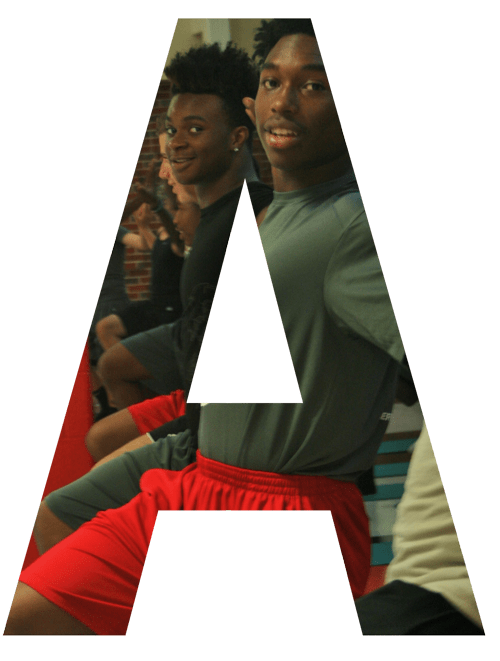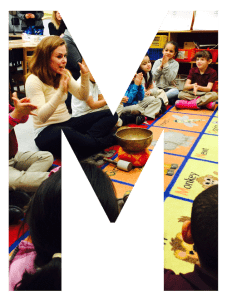How does a 4th grader live her yoga? Thoughts on “I Am What I Am”
Kelli Love is a Certified Grounded Teacher working as a yoga specialist full time in a NYC charter school. Watch this video clip and then read on to learn how she seamlessly weaves best teaching practices with yoga.
The other day one of my students shared that she had recently used yoga during a test. All upper grades students had just taken an interim assessment, which is to say a long test, with the goal of giving her teacher information about what she still needs to learn before the end of year assessment. I was overjoyed that she had transferred her learning to a real life context; when I inquired more, I discovered that her learning was made truly authentic and personal for her. I was proud of her and proud of this work we are all doing to bring yoga and mindfulness to schools. This is the goal of education, isn’t it? I had to ask myself, how was she convinced to use yoga in a time of need? How did she transfer her learning in the yoga room to during test anxiety at school?
Model. Guide. Release. As teachers, we employ the gradual release of responsibility with students.
Model – I often tell my students (K-5 girls) that I do yoga everywhere, even on the subway in NYC, as a way of modeling. I try to think out loud with them about how I live my yoga. They first look at me strangely, as if I am implying I practice arm balances on the train. But by now, they know that I expect them to communicate how they use yoga in their everyday life, at school or at home. And the subway can be the perfect breeding ground for discussion on ‘living your yoga’. It’s a place in NYC where we can all relate to monitoring our emotions and self regulating – people bump into you and don’t give it a second glance, someone else may need your seat when you are already tired, there are unexpected delays…and the list could go on. If you don’t live in NYC, driving in your car probably serves a similar purpose – the looking glass into your own tendencies during stressful environments. Students get the subway example, but one other real life example where the tools of yoga can be put to work is test anxiety. Testing is a regular part of student life and it isn’t going away, in fact the ‘rigor’ has increased. One stressor I often see is the length of tests – students need to build stamina, which is where the yoga comes in. Stamina requires resisting the urge to quit when it gets hard.
Guided Practice – In the beginning of the school year, when practicing the pose “I Am What I Am” I offered it as a tool for decreasing stress during tests. I told students we call it “I Am What I Am” because it’s easy to forget what we already are during a stressful situation, and this pose is one way to remind ourselves that we always have the potential to be strong, focused, and that we can keep going with a calm attitude, even when something is hard. We visualized a situation that might call for resetting our self- talk, such as when we are frustrated during a test, and chanted “I am so focused” and other variations of the pose.
And indeed the pose “I Am What I Am”, has endless variations, and although I find that most students resonate with the original “Sa Ta Na Ma”, when in a public school setting, I choose to use powerful variations that can be interpreted as secular, such as “I am so strong” or “I am so calm” or “I am in charge” because really, when we feel strong, calm, and in charge of our self, we feel prepared to take on any task. So we practiced this pose with various themes, many times, so that students could think about its uses in different contexts. One of my teachers used to tell me that repetition is the spice of life. And that’s the thing about a mantra — after repeating it many times, in a formal practice, it’s there when you need it most, as in when taking a test. The formal practice of chanting eventually translates to everyday contexts, and Naomi’s story was a great example.
Release – As teachers, we can come up with these clever, high impact 4 syllable phrases that resonate strongly, but true authentic transfer is when kids can either choose one of those phrases that are appropriate for their own unique situations or make up their own. And in this case, the student created her own affirmation that was relevant to the moment. She realized that she needed to change the path of self-talk she was going down and so she chose phrases that invited a different attitude. She deliberately changed her mood by using yoga, and thus was able to persist with her work.
We know that the ideal goal is transfer of learning, meaning students translate the concept to different contexts and make it personal. They live their yoga outside of the yoga space. We ultimately get there through the gradual release of responsibility, which means students need to see us living our yoga. They need to hear our stories and ultimately we need to give them time to tell us theirs, through discussion and through writing, during the guided practice phase. The learning therefore becomes authentic to the learner in the independence phase. “I am What I am” is the perfect pose to practice emotion regulation authentically– it reconnects us to the physical body, it refocuses the mind, and is adaptable to any emotion, in all it’s variation. Ultimately, the brilliance of this pose is that it can be done with no one noticing, as in the subway, or at your desk when taking an hour-long interim assessment in 4th grade. Teach it often.


 Have you ever head the term “The Ground Truth”? Spies say it when they want to know what really went down, no cover-ups and no interpretations. Apparently in life or death spy situations it’s important to know the ground truth in order to move forward in the mission. In NASA, the ground truth is part of the calibration process where a person on the ground makes a measurement of the same thing the satellite is trying to measure at the same time. The two answers are then compared to help evaluate how well the satellite instrument is performing.
Have you ever head the term “The Ground Truth”? Spies say it when they want to know what really went down, no cover-ups and no interpretations. Apparently in life or death spy situations it’s important to know the ground truth in order to move forward in the mission. In NASA, the ground truth is part of the calibration process where a person on the ground makes a measurement of the same thing the satellite is trying to measure at the same time. The two answers are then compared to help evaluate how well the satellite instrument is performing.




